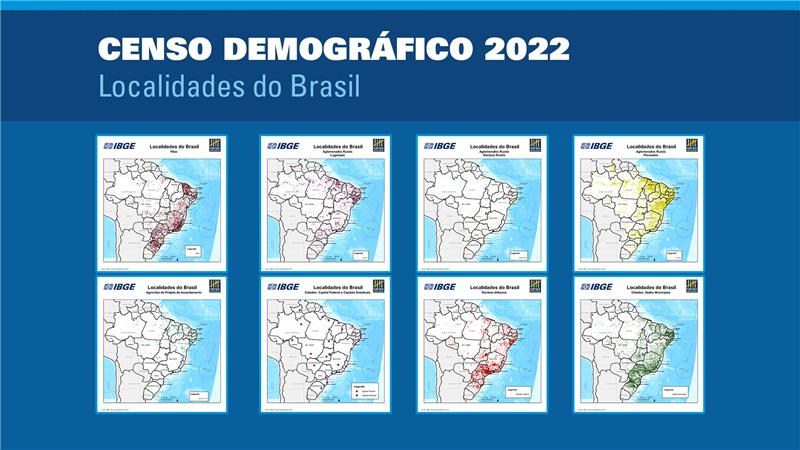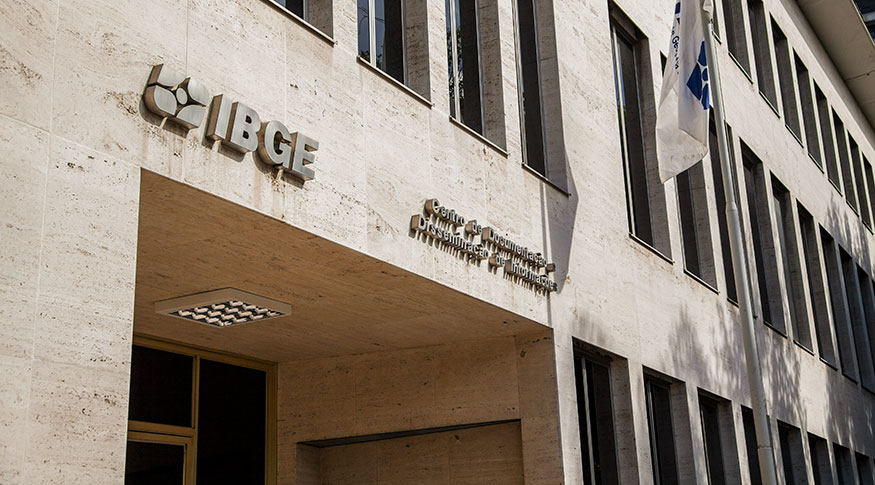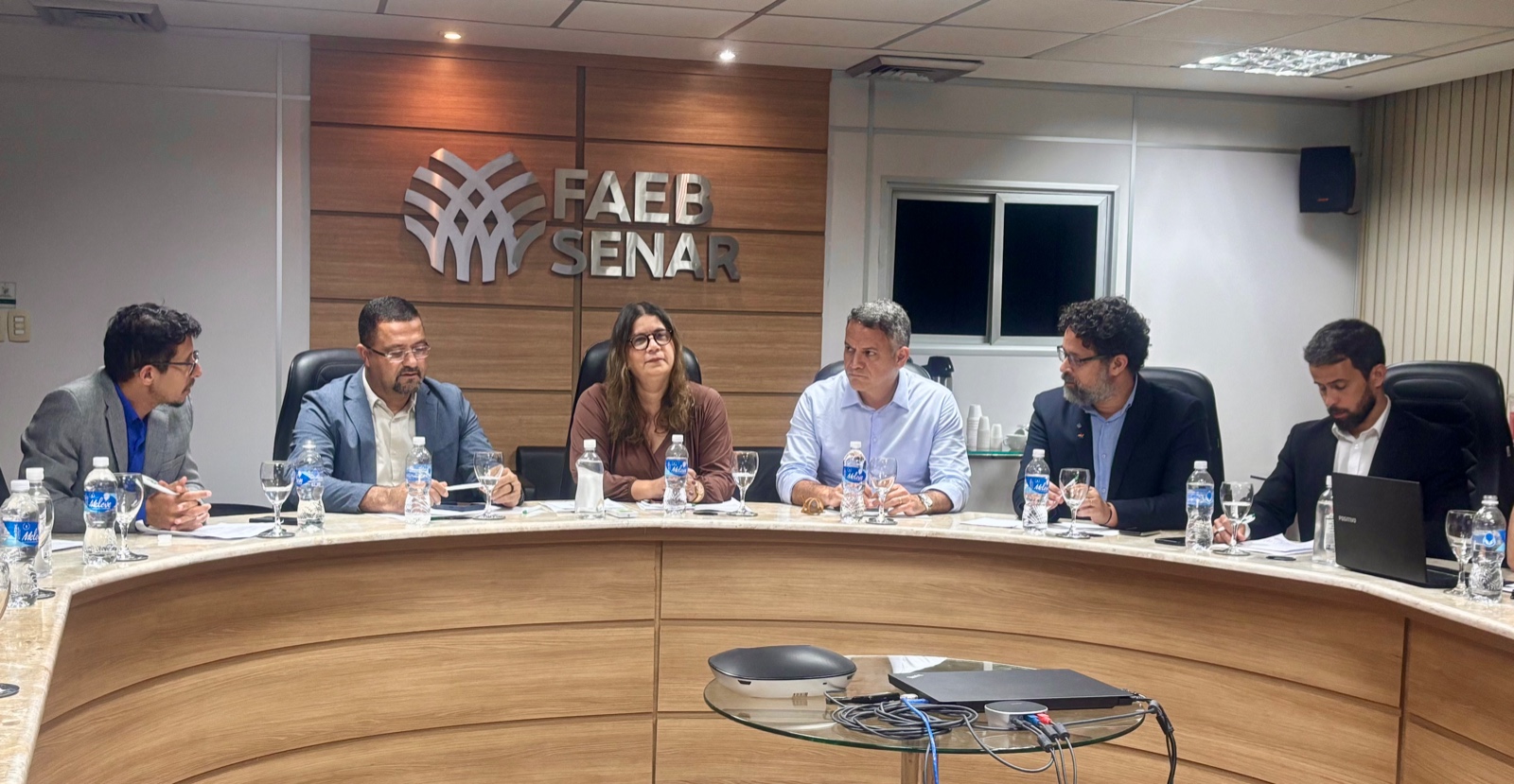Continuous PNAD
Amapá, Piauí, Rondônia and Pará had less than 30% of urban households connected to sewage collection network in 2022
June 16, 2023 10h00 AM | Last Updated: June 19, 2023 04h16 PM
Highlights
- In 2022, Brazil had 74.1 million households and 85.0% of them (or 63.0 million) were houses, whereas 14.9% (or 11.0) million were apartments.
- Between 2019 and 2022, the proportion of households connected to sewage collection network increased from 68.2% to 69.5% of the total number of households in Brazil.
- In 2022, 78.0% of the Brazilian urban households were connected to the sewage collection network. In São Paulo (96.4%), Federal District (94.1%), Minas Gerais (92.3%) and Rio de Janeiro (90.6%), more than 90% of the urban households were connected to the sewage network, whereas in Amapá (23.1%), Piauí (23.3%), Rondônia (27.3%) and Pará (28.0%), less than 30% of the urban households had this service.
- Among the rural households, 40.2% (or 3.7 million) had a septic tank not connected to the network, whereas 50.5% of them (or 4.6 million) had another type of sewage in 2022.
- In Brazil, 9.0% (or 6.4 million) households connected to the general network did not receive water daily in 2022.
- Electricity provided by the general network or alternative source hit 99.8% of the Brazilian households in 2022.
- The proportion of households in which garbage was collected directly by a waste collection service rose from 82.7% in 2016 to 86.0% in 2022.
- Nearly 63.8% of the Brazilian households (or 47.3 million) were privately-owned already canceled and 6.0% (or 4.4 million) were privately-owned still being paid. Other 21.1% (15.7 million) were rented.
- The percentage of households with a washing machine rose from 62.9% in 2016 to 70.2% in 2022.
- In 2022, 15.9% of the Brazilian households had only one resident, against 12.2% in 2012.
- The percentage of senior citizens (60 years and over) in the Brazilian population rose from 11.3% in 2012 to 15.1% in 2022.
- The proportion of persons who self-declared black rose from 7.4% in 2012 to 10.6% em 2022.

In 2022, Brazil had 74.1 million permanent private households and 43.5% of them (or 32.3 million) were in the Southeast. The Northeast registered the second largest parcel, with 26% of the households (or 19.3 million), followed by regions South (15% or 11.1 million), Central-West (7.8% or 5.8 million) and North (7.6% or 5.7 million). This information comes from the General Characteristics of Households and Residents module of the Continuous National Household Sample Survey (PNAD).
Nearly 85.0% (or 63.0 million) of these households were houses, whereas 14.9% (or 11.0 million) were apartments. The Southeast had the biggest percentage of households in apartments, above the national average, with 19.7% (6.3 million). On the other hand, the Central-West was the region where the proportion of apartments mostly grew, changing from 9.6% in 2016 to 12.2% in 2022.
Concerning the material prevailing in the roof of households, 49.8% (36.9 million) had tiles without concrete slab, whereas 32.1% (23.8 million) had tiles with concrete slab. Other 15.2% (11.2 million) had only concrete slabs and 2.9% (2.2 million), other types of material.
In the walls, 88.6% of the Brazilian households used either masonry or coated pug, whereas 6.9% used either masonry or non-coated pug and 3.9% used wood suitable for construction. The North and South regions recorded the highest percentages of households with outside walls of wood (19.2% and 14.5%, respectively).
Nearly 63.8% of Brazilian households were privately-owned and canceled
Among the 74.1 million permanent private households in Brazil, 47.3 million (63.8%) were privately-owned and already paid. However, the predominance of canceled properties has been continuously dropping since 2016, when the percentage was 66.7%. In this period, the percentage of rented households has been increasing, changing from 18.5% in 2016 to 21.1% in 2022 (or 15.7 million). Those yielded were 8.8% (6.6 million) and those under another condition, for instance, the cases of invasion, added up to 0.2% (174 thousand).
Concerning the regional division, the North (72.7%) and Northeast (71%) had higher estimates of canceled privately-owned properties than the national average. In contrast, rented households had a higher proportion in the Central-West (27.8%), Southeast (23.4%) and South (20.9%) regions.
Between 2016 and 2022, the Central-West registered the biggest retraction in the proportion of privately-owned households already canceled (from 59.6% to 51.5%), whilst the proportion of rented households increased (from 24.5% to 27.8%).
The highest percentage of rented households were noticed in the Federal District (35.6%), Goiás (27.3%), Mato Grosso (25.3%) and São Paulo (25.3%), whereas Piauí (10.3%), Maranhão (11.5%), Amapá (12.5%) and Pará (12.8%) recorded the lowest proportions.
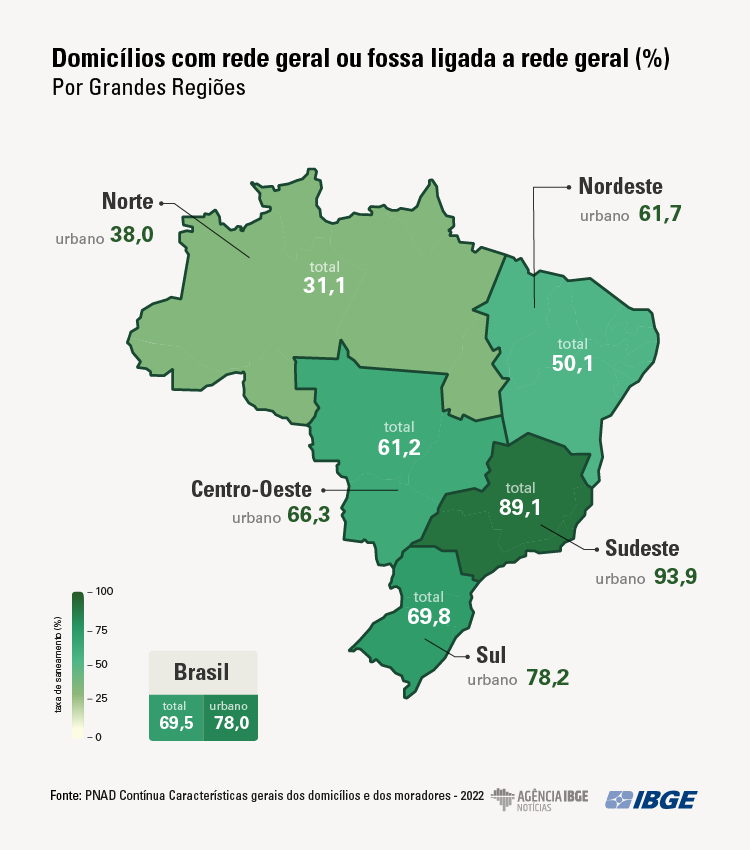
For the first time ever, half of households in Northeast are connected to a sewage collection network
Among the 64.8 million urban households in Brazil in 2022, 99.5% had running water and 95.1% accessed the general water network. Among the 9.4 million rural households, those percentages were 88.2% and 38.9%, respectively.
98.2% of the Brazilian households had bathrooms for exclusive use, whereas those with sewage drained through either the sewage collection network or a septic tank connected to the general network were 69.5%.
Between 2019 and 2022, the proportion of households with sewage drainage through a collection network increased 1.3 percentage points (it was 68.2%). In this period, the regions with the lowest estimates of access to a sewage collection network registered the biggest increases, highlighted by the North (from 27.3% to 31.1%) and Northeast (from 47% to 50.1%) which, for the first time ever, had half of its households connected to a sewage collection network in 2022.
“Even if a small advance in sewage drainage through a collection network has existed in this period, a considerable part of the Brazilian households remains without access to this service. In addition, 14.1% of the households in 2022 resorted either to a rudimentary septic tank or other inadequate forms of draining sewage, like directly in ditches, rivers or sea, which brings risks to the human health and to the environment” explains Gustavo Geaquinto, an analyst of the survey.
Less than 30% of urban households in Amapá, Piauí, Rondônia and Pará were connected to a sewage network
Among the urban households in 2022, 78.0% had sewage drainage through a general collection network. The highest percentages of urban households with this service were in the Southeast (93.9%) and South (78.2%), followed by Central-West (66.3%), Northeast (61.7%) and North (38.0%).
The states with the highest proportions of urban households connected to a sewage collection network were São Paulo (96.4%), Federal District (94.1%), Minas Gerais (92.3%) and Rio de Janeiro (90,6%), the four states with a coverage above 90%.
The lowest proportions of urban households connected to a sewage collection network were in Amapá (23.1%), Piauí (23.3%), Rondônia (27.3%) and Pará (28.0%), the four states with a coverage below 30% for this service.
North Region has the lowest percentage of households connected to water general network: 60.0%
In 2022, 85.5% of the households were connected to a general network of water supply in Brazil. That proportion almost did not change against 2016, when 85.8% of them counted with this service. The North Region had the lowest percentage of households that had a general network as the major form of water supply (60.0%) and the highest percentage of households supplied by artesian wells (23.2%). The Southeast had the highest proportion of households connected to a water general network (91.8%).
In the Northeast, 5.4% of the households (or nearly 1.0 million) had other forms of water supply, like rain water stored in cisterns, tanks, river water, dams or tank trucks (the highest percentage of this type among the Major Regions). In this region, 80.3% of the households were connected to a water general network (the second lowest percentage among the Major Regions) and 9.5% were supplied by artesian wells.
6.4 million households connected to a general network did not receive water daily in 2022
In Brazil, 93.3% of the urban households were connected to a water general network in 2022, and the North (69.9%) was the only region in which this percentage was below 90%. Among the rural households, 32.0% were connected to a water general network, whereas 29.7% were supplied by artesian wells.
In 2022, nearly 9.0% (or 6.4 million Brazilian households) that had a general network as the major way of water supply were not supplied daily, and 3.6 million of these households were in the Northeast.
The Federation Unit with the highest percentages of households that had a general network as the major way of water supply and were supplied daily in 2022 were the Federal District (97.7%), Santa Catarina (97.4%) and Roraima (97.2%), whereas the lowest percentages were found in Pernambuco (42.9%), Acre (47.8%) and Rio Grande do Norte (66.2%).
Access to electricity is virtually universalized, except in rural areas of North
In 2022, electricity arrived in 99.8% of the Brazilian households, a coverage virtually universal, either through a general network or through an alternative source. The coverage of electricity was high, both in urban areas (99.9%) and in rural areas (99.0%). In 99.4% of the households (73.7 million), electricity came from a general network and it was available full time in 98.7% of the cases (72.7 million households).
In rural areas, the percentage of households with electricity coming from a general network was lower (97.3%), especially in the rural areas of the North Region (85.0%).
In 86.0% of the Brazilian households, garbage was directly collected by waste collection services
The proportion of the Brazilian households that had their garbage directly collected by waste collection services has been increasing: from 82.7% in 2016 to 86.0% in 2022. This represents an increase of 14.0% in the total number of households addressed, or more 8.2 million households, in the period.
“Despite that growth, garbage was still burned (in the properties) in a significant number of Brazilian households in 2022. That happened in rural areas, in which more than half of the households had their garbage burned in the properties as the major destination,” notes Geaquinto. Indeed, garbage burned in properties was practiced in 6.8% of the Brazilian households, whereas garbage collected in containers of waste collection services occurred in 6.2% of the Brazilian households. In rural households, such percentages were 51.2% and 11.5%, respectively.
Considering the urban households alone, garbage was collected by waste collection services in 93.8% of the households. The Northeast was the only Major Region in which this service addressed less than 90% of the urban households in 2022, reaching 88.4% of the households.
In rural areas, the South Region had the highest proportion of households in which garbage was collected by waste collection services in 2022: 47.6%.
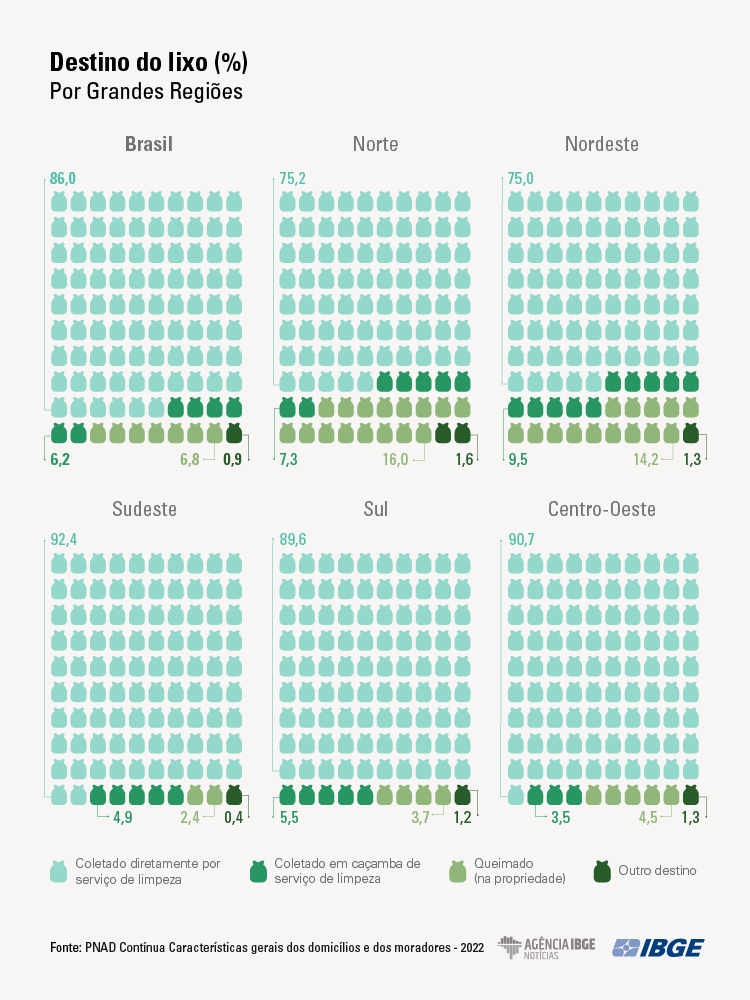
More households with motorcycles than cars in North and Northeast
The North and Northeast were the only Brazilian regions in which the percentages of households with motorcycles (35.3% and 33.0%, respectively) surpassed those with cars (30.7% and 29.9%). The two highest percentages of ownership of motorcycles were also noticed in these two regions (35.3% and 33.0%), whereas the Southeast (18.8%) had the lowest proportion.
In Brazil, 49.8% of the households had cars, 25.0% had motorcycles and 13.1%, both. The South Region had the highest percentage of households with cars (69.2%), whereas the Northeast and North had the lowest proportions of cars (29.9% and 30.7%, respectively).
In Brazil, 98.4% of the households had refrigerators in 2022, a percentage that varied between 94.5% in the North and 99.5% in the South. Washing machines were present in 70.2% of the Brazilian households, with large regional differences: the Northeast (41.1%) and North (55.0%) had the lowest percentages, whereas the South (89.3%), Southeast (81.8%) and Central-West (80.2%) had the highest ones.
15.9% of Brazilian households had only one resident in 2022
In 2022, nearly 15.9% of the Brazilian households had only one resident and this share grew 3.7 percentage points over 2012 (12.2%). Among persons who lived alone, 45.9% were aged between 30 and 59 years and 41.8% were senior citizens (60 years and over).
“The increase in the number of sole households hides an important detail: while 55.9% of men who lived alone in 2022 were aged between 30 and 59 years, most (57.5%) women living alone were aged 60 years and over,” highlights Geaquinto.

In 2022, nuclear arrangements (couples with or without children, including adopted children, stepchildren or foster children) were the most frequent in Brazil, found in 66.3% of the households. Single-parent families (those with only one parent living with their children) are also nuclear arrangements. Prevailing in the entire time series, the share of nuclear arrangements had been reducing since 2012, when it was found in 68.3% of the Brazilian households.
The other forms of family arrangements were the extended family (person responsible for the household with at least one relative), with a share of 16.5% in 2022, and the composite families (person responsible for the household, with or without relatives, and at least one unrelated person), representing 1.4% of the total number of occupied households.
Between 2012 and 2022, proportion of senior citizens in population rises from 11.3% to 15.1%
The population of persons aged below 30 years fell to 43.3% in 2022. In 2012, that estimate had been 49.9%. On the other hand, the population aged over 30 years grew, hitting 56.7% in 2022 against 50.1% in 2012.
Between 2012 and 2022, the drop in the share of persons aged between 10 and 13 years (from 6.7% to 5.4%) and between 14 and 17 years (from 7.1% to 5.6%) stood out as well.
In 2022, the parcel of senior citizens (aged 60 years and over) represented 15.1% of the population against the estimate of 11.3% in 2012.
Proportion of persons who self-declared black grows from 7.4% in 2012 to 10.6% in 2022
In 2022, nearly 45.3% of the Brazilian population self-declared as brown, followed by the groups who self-declared as white (42.8%) and black (10.6%). Between 2012 and 2022, the share of the Brazilian population who self-declared as white reduced by 3.5 percentage points, varying from 46.3% in 2012 to 42.8% in 2022. In the same period, the proportion of those who self-declared as black grew from 7.4% to 10.6%.
In the brown population, the variation of the shares between 2012 and 2022 was lower, from 45.6% to 45.3%, even if the percentage of this group of color or race in the total population has hit 47.1% in 2016.
Between 2012 and 2022, the share of the white population in th total number of inhabitants decreased in every region. In the same period, the largest increase of share of black persons (from 8.7% to 13.4%) occurred in the Northeast, whereas the largest increase in the proportion of brown persons (from 16.7% to 20.9%) occurred in the South.













